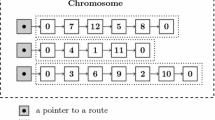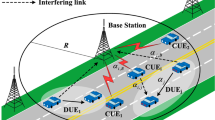Abstract
In the networking of vehicles, the information exchange between network infrastructure and vehicles is very important. However, at the current development stage of the networking of vehicles, the coverage of a single network infrastructure is very limited, and each network base station has a variety of heterogeneous wireless networks with different performances. Vehicles must constantly switch between multiple network infrastructures, so the efficiency of information transmission becomes crucial, among which the key problems are mainly service delay and service cost in the transmission of broadcast data packets. In this paper, this key problem is summarized as the multi-objective problem. The MOEA/D-DE algorithm is proposed by adding differential evolution variation to the multi-objective evolutionary algorithm, which makes the population variation more diverse. On the basis of the convergence of the original multi-objective optimization algorithm, more diverse new individuals are generated, which makes the original convergence state broken and the population continues to evolve. A large number of simulation experiments are conducted, and the experimental results show that this method can obtain smaller average service delay and average access cost, and has good scalability, that is, it is effective for a variety of data transmission scenarios, and compared with the traditional packet sending algorithm and MOEA/D algorithm, more shows the superiority of this algorithm.








Similar content being viewed by others
Data Availability
The data used to support the findings of this study are available from the corresponding author upon request.
References
Azimifar M, Todd TD, Khezrian A, Karakostas G (2016) Vehicle-to-vehicle forwarding in green roadside infrastructure. IEEE Trans Veh Technol 65(2):780–795
Bai F, Stancil DD, Krishnan H (2010) Toward understanding characteristics of dedicated short range communications (DSRC) from a perspective of vehicular network engineers. In: International conference on mobile computing & networking. DBLP
Chen Y, He F, Li H, Zhang D, Wu Y (2020) A full migration BBO algorithm with enhanced population quality bounds for multimodal biomedical image registration. Appl Soft Comput 93:106335
Dai P, Liu K, Wu X, Xing H, Lee V (2019) Multi-objective optimization for network resource management in heterogeneous vehicular networks. In: IEEE wireless communications and networking conference (WCNC), pp 1–6
Dong Z, Wang X, Tang L (2020) MOEA/D with a self-adaptive weight vector adjustment strategy based on chain segmentation. Inf Sci 521:209–230
Hung R, Ting H (2008) Competitive analysis of most-request-first for scheduling broadcasts with start-up delay. Theor Comput Sci 396(1):200–211
Kai L, Ng KY, Wang J, Lee V, Wu W, Sang HS (2016) Network-coding-assisted data dissemination via cooperative vehicle-to-vehicle/-infrastructure communications. IEEE Trans Intell Transp Syst 17(6):1509–1520
Kcd A, Ar B, Mc C, Pb D, Jm E (2016) Vehicle-to-vehicle (v2v) and vehicle-to-infrastructure (v2i) communication in a heterogeneous wireless network-performance evaluation. Transp Res Part C Emerg Technol 68:168–184
Li H, He F, Chen Y, Pan Y (2021) MLFS-CCDE: multi-objective large-scale feature selection by cooperative coevolutionary differential evolution. Memet Comput 13:1–18
Liang Y, He F, Zeng X, Luo J (2022) An improved loop subdivision to coordinate the smoothness and the number of faces via multi-objective optimization. Integr Comput Aided Eng 29(1):23–41
Machardy Z, Khan A, Obana K, Iwashina S (2018) V2x access technologies: regulation, research, and remaining challenges. IEEE Commun Surv Tutor 20(3):1858–1877
Naderi E, Mirzaei L, Pourakbari-Kasmaei M, Cerna FV, Lehtonen M (2023) Optimization of active power dispatch considering unified power flow controller: application of evolutionary algorithms in a fuzzy framework. Evol Intel. https://doi.org/10.1007/s12065-023-00826-2
Qi W, Landfeldt B, Song Q, Guo L, Jamalipour A (2020) Traffic differentiated clustering routing in DSRC and C-V2X hybrid vehicular networks. IEEE Trans Veh Technol PP(99):1
Ran D, Wu C, Yoshinaga T, Zhang J, Ji Y (2020) SDN-based handover scheme in cellular/IEEE 802.11p hybrid vehicular networks. Sensors 20(4):1082
Sahoo KS, Sahoo B (2016) Sdn architecture on fog devices for realtime traffic management: a case study. In: Proceedings of the international conference on signal, networks, computing, and systems: ICSNCS, vol 1, pp 323–329
Wilhelm M, Higuchi T, Altintas O (2016) Geo-spatial resource allocation for heterogeneous vehicular communications: poster. In: Proceedings of the 17th ACM international symposium on mobile ad hoc networking and computing, series MobiHoc 16, pp 399–400
Wong JW (1988) Broadcast delivery. In: Proceedings of the IEEE, vol 76, no (12), pp 1566–1577
Xin MZ, Kai HC, Xu LC, Dan KS (2016) A street-centric routing protocol based on microtopology in vehicular ad hoc networks. IEEE Trans Veh Technol 65(7):5680–5694
Yang L, Zhang L, He Z, Cao J, Wu W (2019) Efficient hybrid data dissemination for edge-assisted automated driving. IEEE Internet Things J PP(99):1
You H, Ekici E, Kremo H, Altintas O (2017) Throughput-efficient channel allocation algorithms in multi-channel cognitive vehicular networks. IEEE Trans Wirel Commun 16(2):757–770
Yu R, Zhang Y, Gjessing S, Xia W, Yang K (2013) Toward cloud-based vehicular networks with efficient resource management. IEEE Netw 27(5):1308
Zhang Q, Hui L (2008) MOEA/D: a multiobjective evolutionary algorithm based on decomposition. IEEE Trans Evol Comput 11(6):712–731
Acknowledgements
This work was supported by the National Natural Science Foundation of China (Grant Nos. 61972456, 62172298); Tianjin Research Innovation Project for Postgraduate Students (2022SKY145); Innovation Fund for Combination of industry and education in China (2022BL083).
Author information
Authors and Affiliations
Contributions
All authors contributed to the study conception and design. Material preparation, data collection and analysis were performed by Z-PC and Z-YC. The first draft of the manuscript was written by Z-PC, and subsequent revisions were made by Y-YC. All authors read and approved the final manuscript.
Corresponding author
Ethics declarations
Conflict of interest
The authors have no relevant financial or non-financial interests to disclose.
Additional information
Publisher's Note
Springer Nature remains neutral with regard to jurisdictional claims in published maps and institutional affiliations.
Rights and permissions
Springer Nature or its licensor (e.g. a society or other partner) holds exclusive rights to this article under a publishing agreement with the author(s) or other rightsholder(s); author self-archiving of the accepted manuscript version of this article is solely governed by the terms of such publishing agreement and applicable law.
About this article
Cite this article
Chai, ZY., Cheng, YY. & Chen, ZP. Network access selection in heterogeneous Internet of vehicles based on improved multi-objective evolutionary algorithm. J Ambient Intell Human Comput 15, 673–682 (2024). https://doi.org/10.1007/s12652-023-04724-4
Received:
Accepted:
Published:
Issue Date:
DOI: https://doi.org/10.1007/s12652-023-04724-4




